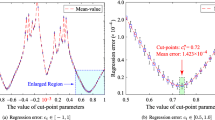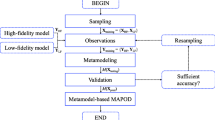Abstract
A ubiquitous challenge in design space exploration or uncertainty quantification of complex engineering problems is the minimization of computational cost. A useful tool to ease the burden of solving such systems is model reduction. This work considers a stochastic model reduction method (SMR), in the context of polynomial chaos expansions, where low-fidelity (LF) samples are leveraged to form a stochastic reduced basis. The reduced basis enables the construction of a bi-fidelity (BF) estimate of a quantity of interest from a small number of high-fidelity (HF) samples. A successful BF estimate approximates the quantity of interest with accuracy comparable to the HF model and computational expense close to the LF model. We develop new error bounds for the SMR approach and present a procedure to practically utilize these bounds in order to assess the appropriateness of a given pair of LF and HF models for BF estimation. The effectiveness of the SMR approach, and the utility of the error bound are presented in three numerical examples.






















Similar content being viewed by others
Availability of data and materials
The datasets generated during and/or analyzed during the current study will be uploaded to the GitHub page www.github.com/CU-UQ once the paper is published.
References
Alnæs MS, Blechta J, Hake J, Johansson A, Kehlet B, Logg A, Richardson C, Ring J, Rognes ME, Wells GN (2015) The fenics project version 1.5. Arch Numer Softw 3(100)
Berry AC (1941) The accuracy of the gaussian approximation to the sum of independent variates. Trans Am Math Soc 49(1):122–136
Blatman G, Sudret B (2010) An adaptive algorithm to build up sparse polynomial chaos expansions for stochastic finite element analysis. Probab Eng Mech 25(2):183–197
Blatman G, Sudret B (2011) Adaptive sparse polynomial chaos expansion based on least angle regression. J Comput Phys 230(6):2345–2367
Candès EJ, Wakin MB (2008) An introduction to compressive sampling. IEEE Signal Process Mag 25(2):21–30
Chandrasheka P (2020) http://cpraveen.github.io
Cheng H, Gimbutas Z, Martinsson PG, Rokhlin V (2005) On the compression of low rank matrices. SIAM J Sci Comput 26(4):1389–1404
Cliffe KA, Giles MB, Scheichl R, Teckentrup AL (2011) Multilevel Monte Carlo methods and applications to elliptic PDEs with random coefficients. Comput Vis Sci 14(1):3
Constantine PG, Doostan A, Iaccarino G (2009) A hybrid collocation/galerkin scheme for convective heat transfer problems with stochastic boundary conditions. Int J Numer Methods Eng 80(6–7):868–880
De S, Britton J, Reynolds M, Skinner R, Jansen K, Doostan A (2020) On transfer learning of neural networks using bi-fidelity data for uncertainty propagation. Int J Uncertain Quant 10(6):543–573
Diaz P, Doostan A, Hampton J (2018) Sparse polynomial chaos expansions via compressed sensing and d-optimal design. Comput Methods Appl Mech Eng 336:640–666
Diskin B, Thomas J, Rumsey CL, Schwöppe A (2015) Grid convergence for turbulent flows, p 1746
Donoho DL (2006) Compressed sensing. IEEE Trans Inf Theory 52(4):1289–1306
Doostan A, Owhadi H (2011) A non-adapted sparse approximation of PDEs with stochastic inputs. J Comput Phys 230(8):3015–3034
Doostan A, Ghanem RG, Red-Horse J (2007) Stochastic model reduction for chaos representations. Comput Methods Appl Mech Eng 196(37–40):3951–3966
Doostan A, Geraci G, Iaccarino G (2016) A bi-fidelity approach for uncertainty quantification of heat transfer in a rectangular ribbed channel. American Society of Mechanical Engineers, pp V02CT45A031–V02CT45A031
Eldred M (2009) Recent advances in non-intrusive polynomial chaos and stochastic collocation methods for uncertainty analysis and design, p 2274
Ernst OG, Mugler A, Starkloff HJ, Ullmann E (2012) On the convergence of generalized polynomial chaos expansions. ESAIM Math Model Numer Anal 46(2):317–339
Fairbanks HR, Doostan A, Ketelsen C, Iaccarino G (2017) A low-rank control variate for multilevel Monte Carlo simulation of high-dimensional uncertain systems. J Comput Phys 341:121–139
Fairbanks HR, Jofre L, Geraci G, Iaccarino G, Doostan A (2020) Bi-fidelity approximation for uncertainty quantification and sensitivity analysis of irradiated particle-laden turbulence. J Comput Phys 402:108996
Fernández-Godino MG, Park C, Kim NH, Haftka RT (2016) Review of multi-fidelity models. arXiv preprint arXiv:1609.07196
Forrester AI, Sóbester A, Keane AJ (2007) Multi-fidelity optimization via surrogate modelling. Proc R Soc A Math Phys Eng Sci 463(2088):3251–3269
Ghanem R, Saad G, Doostan A (2007) Efficient solution of stochastic systems: application to the embankment dam problem. Struct Saf 29(3):238–251
Ghanem RG, Spanos PD (1991) Stochastic finite element method: response statistics. In: Stochastic finite elements: a spectral approach, pp 101–119. Springer
Ghia U, Ghia KN, Shin C (1982) High-re solutions for incompressible flow using the Navier–Stokes equations and a multigrid method. J Comput Phys 48(3):387–411
Giles MB (2008) Multilevel Monte Carlo path simulation. Oper Res 56(3):607–617
Giles MB (2013) Multilevel Monte Carlo methods. In: Monte Carlo and quasi-Monte Carlo methods 2012, pp 83–103. Springer
Gu M, Eisenstat SC (1996) Efficient algorithms for computing a strong rank-revealing qr factorization. SIAM J Sci Comput 17(4):848–869
Hampton J, Doostan A (2015a) Coherence motivated sampling and convergence analysis of least squares polynomial chaos regression. Comput Methods Appl Mech Eng 290:73–97
Hampton J, Doostan A (2015b) Compressive sampling of polynomial chaos expansions: convergence analysis and sampling strategies. J Comput Phys 280:363–386
Hampton J, Fairbanks HR, Narayan A, Doostan A (2018) Practical error bounds for a non-intrusive bi-fidelity approach to parametric/stochastic model reduction. J Comput Phys 368:315–332
Hill PG, Peterson CR (1992) Mechanics and thermodynamics of propulsion. Addison-Wesley Publishing Co, Reading
Kennedy MC, O’Hagan A (2000) Predicting the output from a complex computer code when fast approximations are available. Biometrika 87(1):1–13
Kleiber W, Sain SR, Heaton MJ, Wiltberger M, Reese CS, Bingham D et al (2013) Parameter tuning for a multi-fidelity dynamical model of the magnetosphere. Ann Appl Stat 7(3):1286–1310
Laurenceau J, Sagaut P (2008) Building efficient response surfaces of aerodynamic functions with kriging and cokriging. AIAA J 46(2):498–507
Le Gratiet L, Cannamela C (2015) Cokriging-based sequential design strategies using fast cross-validation techniques for multi-fidelity computer codes. Technometrics 57(3):418–427
Le Gratiet L, Garnier J (2014) Recursive co-kriging model for design of computer experiments with multiple levels of fidelity. Int J Uncertain Quant 4(5):365–386
Le Maître O, Knio OM (2010) Spectral methods for uncertainty quantification: with applications to computational fluid dynamics. Springer, Berlin
Lyall ME, Thrift AA, Thole KA, Kohli A (2011) Heat transfer from low aspect ratio pin fins. J Turbomach 133(1):011001
Martinsson R, Tygert M (2011) A randomized algorithm for the decomposition of matrices. Appl Comput Harmon Anal 30(1):47–68
Mathelin L, Gallivan K (2012) A compressed sensing approach for partial differential equations with random input data. Commun Comput Phys 12(4):919–954
Narayan A, Gittelson C, Xiu D (2014) A stochastic collocation algorithm with multifidelity models. SIAM J Sci Comput 36(2):A495–A521
Ng LWT, Eldred M (2012) Multifidelity uncertainty quantification using non-intrusive polynomial chaos and stochastic collocation, p 1852
Padron AS, Alonso JJ, Eldred MS (2016) Multi-fidelity methods in aerodynamic robust optimization, p 0680
Palar PS, Tsuchiya T, Parks G (2015) Decomposition-based evolutionary aerodynamic robust optimization with multi-fidelity point collocation non-intrusive polynomial chaos, p 1377
Parussini L, Venturi D, Perdikaris P, Karniadakis GE (2017) Multi-fidelity gaussian process regression for prediction of random fields. J Comput Phys 336:36–50
Peherstorfer B, Willcox K, Gunzburger M (2018) Survey of multifidelity methods in uncertainty propagation, inference, and optimization. Siam Rev 60(3):550–591
Peng J, Hampton J, Doostan A (2014) A weighted \(\ell _1\)-minimization approach for sparse polynomial chaos expansions. J Comput Phys 267:92–111
Perdikaris P, Venturi D, Royset JO, Karniadakis GE (2015) Multi-fidelity modelling via recursive co-kriging and Gaussian–Markov random fields
Perdikaris P, Venturi D, Karniadakis GE (2016) Multifidelity information fusion algorithms for high-dimensional systems and massive data sets. SIAM J Sci Comput 38(4):B521–B538
Pope SB (2001) Turbulent flows
Raisee M, Kumar D, Lacor C (2015) A non-intrusive model reduction approach for polynomial chaos expansion using proper orthogonal decomposition. Int J Numer Methods Eng 103(4):293–312
Shevtsova I (2011) On the absolute constants in the Berry–Esseen type inequalities for identically distributed summands. arXiv preprint arXiv:1111.6554
Skinner RW, Doostan A, Peters EL, Evans JA, Jansen KE (2019) Reduced-basis multifidelity approach for efficient parametric study of naca airfoils. AIAA J 57(4):1481–1491
Spalart P, Allmaras S (1992) A one-equation turbulence model for aerodynamic flows, p 439
Whiting CH, Jansen KE (2001) A stabilized finite element method for the incompressible Navier–Stokes equations using a hierarchical basis. Int J Numer Methods Fluids 35(1):93–116
Xiu D (2010) Numerical methods for stochastic computations: a spectral method approach. Princeton University Press, Princeton
Xiu D, Karniadakis GE (2002) The Wiener–Askey polynomial chaos for stochastic differential equations. SIAM J Sci Comput 24(2):619–644
Yan L, Guo L, Xiu D (2012) Stochastic collocation algorithms using \(\ell _1\)-minimization. Int J Uncertain Quant 2(3):279–293
Yang X, Karniadakis GE (2013) Reweighted \(\ell _1\)-minimization method for stochastic elliptic differential equations. J Comput Phys 248:87–108
Zhu X, Narayan A, Xiu D (2014) Computational aspects of stochastic collocation with multifidelity models. SIAM/ASA J Uncertain Quant 2(1):444–463
Acknowledgements
The work of FN was supported by NSF Grants 1740330 and 2028032. JH has received funding from the European Union’s Horizon 2020 research and innovation programme under the Marie Skłodowska-Curie Grant Agreement No. 712949 (TECNIOspring PLUS) and from the Agency for Business Competitiveness of the Government of Catalonia. The work of AD was also supported by the AFOSR Grant FA9550-20-1-0138 and NSF Grant 1454601.
Author information
Authors and Affiliations
Corresponding author
Ethics declarations
Conflict of interest
The authors have no relevant financial or non-financial interests to disclose.
Code availability
The code used in this study will be made available once the paper is published at the GitHub page www.github.com/CU-UQ.
Additional information
Publisher's Note
Springer Nature remains neutral with regard to jurisdictional claims in published maps and institutional affiliations.
A Appendix
A Appendix
- \(\varvec{\varXi }\) :
-
Vector of random variables
- \(\varvec{{u}}\) :
-
Vector valued QoI
- \(\varvec{{c}}_j\) :
-
PC expansion coefficients
- \(\psi _{j}\) :
-
Polynomial basis functions
- \(\varvec{\delta }_P\) :
-
PC expansion truncation error
- p :
-
PC total order
- \(\varvec{{C}}\) :
-
Matrix of PC coefficients
- \(\varvec{\xi }_i\) :
-
ith realization of random variable vector \(\varvec{\varXi }\)
- \(\varvec{{U}}\) :
-
Matrix of QoI \(\varvec{{u}}\) samples
- N :
-
Number of samples in \(\varvec{{U}}\), \(\varvec{{L}}\) and \(\varvec{{H}}\)
- \(\varvec{\varPsi }\) :
-
Measurement matrix for PC regression
- \(\varvec{{u}}^L\) :
-
LF QoI
- \(\varvec{{u}}^H\) :
-
HF QoI
- m :
-
LF QoI dimension
- M :
-
HF QoI dimension
- \(\varvec{{L}}\) :
-
Matrix of LF data
- \(\varvec{{H}}\) :
-
Matrix of HF data
- \(\varvec{{c}}_j^L\) :
-
PC expansion coefficients from LF data
- \(\eta _{i}\) :
-
Reduced basis functions
- r :
-
Number of basis functions in SMR reduced basis; number of HF samples in MID
- \(\varvec{{c}}_{j}^B\) :
-
BF coefficients
- \({\varvec{\delta }}_{r}\) :
-
Total error in BF estimate
- \(\varvec{{u}}^B\) :
-
SMR BF QoI estimate
- \(\varvec{{C}}^B\) :
-
SMR Matrix of BF coefficients
- \(\varvec{{H}}_n\) :
-
SMR Limited number of n HF samples
- \(\varvec{\eta }_n\) :
-
Reduced basis measurement matrix for n samples
- n :
-
Number of HF samples in SMR estimate
- \(\varvec{\eta }_N\) :
-
Reduced basis measurement matrix for N samples
- \({\widehat{\varvec{{H}}}}\) :
-
SMR BF estimate of \(\varvec{{H}}\)
- \({\bar{\varvec{{C}}}}^L\) :
-
Matrix of MID interpolation coefficients
- \({\bar{\varvec{{L}}}}^L\) :
-
MID BF estimate of \(\varvec{{L}}\)
- \(\varvec{{H}}_r\) :
-
MID limited number of r HF samples
- \({\bar{\varvec{{H}}}}^L\) :
-
MID BF estimate of \(\varvec{{H}}\)
Rights and permissions
About this article
Cite this article
Newberry, F., Hampton, J., Jansen, K. et al. Bi-fidelity reduced polynomial chaos expansion for uncertainty quantification. Comput Mech 69, 405–424 (2022). https://doi.org/10.1007/s00466-021-02096-0
Received:
Accepted:
Published:
Issue Date:
DOI: https://doi.org/10.1007/s00466-021-02096-0




